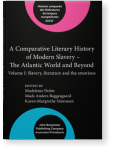Chapter 17
The blood-stained-gate
An archive of emotion and authenticity in the new slave narrative
This chapter suggests that the slave narrative employs metonymy as an archive of memory when
authors are unwilling or unable to articulate the experience of trauma explicitly. Drawing on Frederick Douglass’s use
of the “blood-stained gate” metaphor as a repository for his emotional suffering, it describes how blood serves as a
metonymic vehicle for communicating authenticity in narratives in which affective descriptions run counter to the
ambitions of the genre. Ismael Beah’s A Long Way Gone: Memoirs of a Boy Soldier (2007) and Emmanuel
Jal’s War Child (2008) present contrasting cases of
blood’s capacity to serve as a repository for the emotional content of war. The trope of blood is then is used a lens
for understanding why audiences respond skeptically to slave narratives and suggests a less suspicious reading
practice among scholars and activists.
Article outline
- Aunt Hester’s blood
- Blood as metonymic archive for emotions
- The blood that binds
- The doubleness of blood for victim-perpetrators
- Convention and doubt
-
Acknowledgements
-
References
This content is being prepared for publication; it may be subject to changes.
